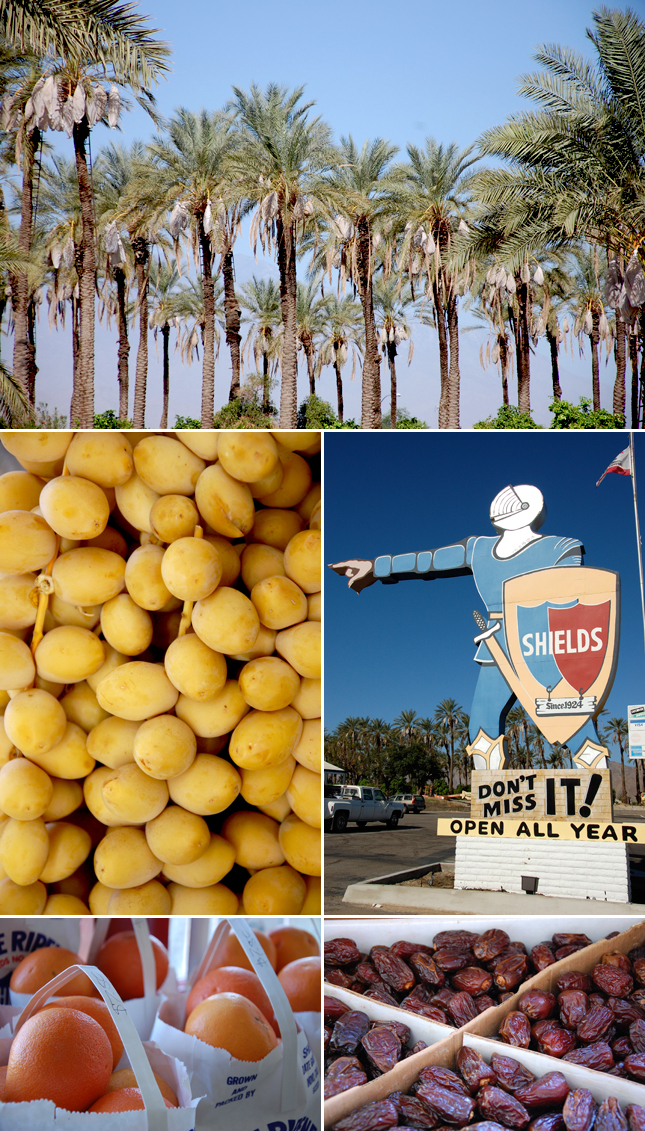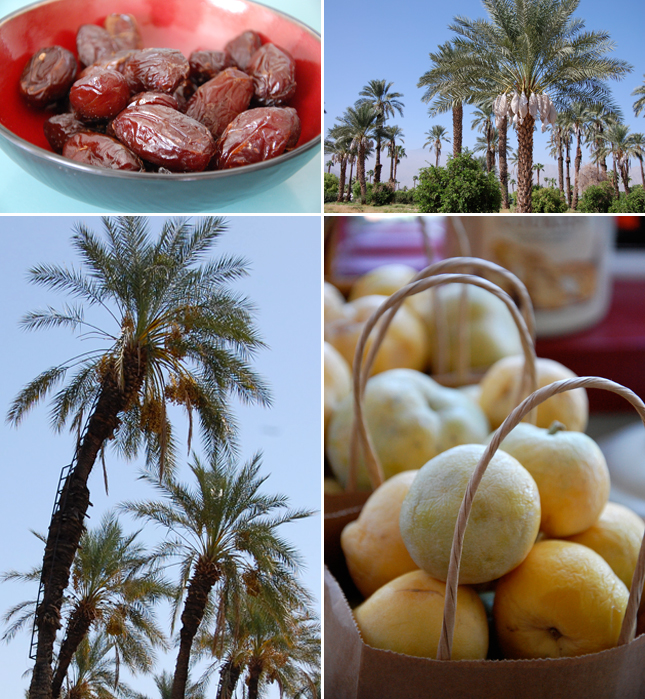Dates - the Desert's Candy

It’s surprising how much there is to know about a single, little food item. Take the ancient, often overlooked in Western cultures, date palm. Who would have thought it could be so remarkable?
The date palm is possibly the oldest cultivated plant of all, dating back to 4,000 BCE. Archeological evidence shows that the trunks of date palms were used in the construction of the Moon Temple in Ur in the time of the Mesopotamians. The palm was coveted for more than just being a practical building material or for its ability to stop desertifaction. Most importantly it was revered because of its fruit, one of the most prized of all delicacies in the Arab world.
How the ancients came to fully understand this contradictory plant is still a mystery. Somehow through the ages men learned how to cultivate this temperamental plant and exploit it to their advantage. There are many tricky aspects of date cultivation not least of which is just keeping the plants alive. The date palm is a desert plant but requires hundreds of gallons of water. The Arab expression is: “A date palm must have it’s feet in the water and its head in the fire of the sun.” In commercial production date groves are flooded in up to ten feet of water. While these palms demand hundreds of gallons of ground water, rain is extremely harmful to the fronds, trunks and fruit hence our vision of them forming the shade of oases. They also provide protection from harsh winds and provide insulation from the cold. The nutrient and sugar dense date sustained many desert peoples and remains an extremely important subsistence crop.
Though dates are widely cultivated, no truly wild plant has ever been found. Its progenitor is believed to be Phoenix reclinata Jacq from tropical Africa, or Phoenix sylvestris (L). Roxb. from India, or a hybrid between these two. Both these species have palatable, although inferior fruits. The difficulty with tracing the palm’s lineage stems from the twofold method with which they reproduce. The most common manner is from the seed of a dropped date fruit. The seeds are drupes which are indigestible and are passed through the bellies of birds and other vertebrates large enough to ingest the fruit. Every time a drupe is dropped and sprouts an entirely new kind of date palm is created. No date tree grown from a seed is alike.
The other method is cultivation of sprouts that jut from the base of the date palm's trunk. This is the only method of reproduction that enables farmers to keep a pure varietal strain of date. A date palm will produce 10 to 25 offshoots near their base during the first 15 years of life. After that, no more. More bizarre is that male plants produce only males and females only spawn females.
It takes a female date palm over five years to begin bearing edible fruit, something it cannot do, of course without being pollinated. There is, however, no naturally adequate method of pollination for dates. Mankind has been hand-pollinating dates for over 3,500 years. On commercial date farms one male plant grows per acre. In the spring workers scale the trunk, collect the powdery pollen then scale the female palms and apply it directly to the buds. It is an extremely dangerous operation not just because date palms grow to be upwards of 100-120 feet, but because of the dangerous thorns that grow among the palm fronds. A female will only produce as many dates as she has green leaves. The lower the number of fronds, the lower the yield.
All this combines to make dates one of the world’s most expensive crops.

The entirety of the date industry in the US is in or near Indio, California, a town about 20 miles south of Palm Desert and near the Salton Sea, the largest lake in California. (Local legend asserts that the lake was formed in 1905 when the Imperial Valley dike was breached. Water flowed over the dike for two years flooding the area and forming the lake. The truth is more prosaic. The Salton Basin has been either full of water or empty since the Pleistocene Age, or the time of the great glacial upheaval in what is now North America. It is true that the water found there today is from the breached dike.)
With the re-filling of the Salton Basin in the early 20th century the region boomed. Among the many arrivals were Floyd and Bess Shields who came to the area from Iowa and Kansas respectively, in the 1920s. The hot climate and the abundance of water made the valley a natural home for numerous exotic crops from citrus to figs to zapote to dates. Presently 95% of the domestically produced dates come from the Coachella Valley.
Shields Date Garden is open year-round where you can try one of their famous date shakes or view the film “The Romance and Sex Life of the Date”.
Shield's Date Garden
80-225 U.S. Highway 111
Indio, CA 92201-6599
To order dates call 800-414-2555
Choosing dates:
High grade, top-quality dates are never sprayed with pesticide or treated with preservatives. Dates do not need to be refrigerated but, unlike most other fruits, keep best when frozen. They can be stored in air-tight containers for up to a year.
Dates ripen in four stages, which are known throughout the world by their Arabic names kimri (unripe), khalal (full-size, crunchy), rutab (ripe, soft), tamr (ripe, sun-dried).
Types of Dates:
There are numerous varieties of dates. The most commonly grown in the US are:
Deglet Noor: This cultivar comes in many grades. They are generally full, plump and have a lower moisture content but are not overly sticky. They are very soft when ripe.
Medjool: Much larger than other dates and very soft. The Medjool’s roots can be traced back to the oases of Morocco. They are rare and deemed the best of all the date varieties. The word Medjool is Arabic for “unknown.” In many Arab households Medjool dates are served on special occasions or offered to honored guests as a token of esteem.
Barhi: The softest of all dates and has a tannic skin reminiscent of persimmon.
Halawi: Characterized by thick flesh that is caramelly and extremely sweet.
Khadrawi: This is an “invert sugar” date. This means that they will crystalize the way honey might when left unused for a period of time.
Thoory (also known as the Bread Date): The most commonly consumed date in the Middle East. The less sweet and drier texture makes it one of the firmest of all varieties.
Zahidi: Small, firm dates. Low sugar content.
Other types of dates: Abbada, Aabel, Ajwah, Al-Barakah, Amir Hajj or 'Amer Hajj', Blond & Brunette (hybrid dates developed in California by Floyd Shields in Indio, CA), Derrie, Ftimi, Haleema, Hayany, Khadrawi, Khadrawy (Arabic: green), Khalasah, Khastawi, Maktoom, Manakbir, Migraf,Mgmaget Ayuob, Rotab, Sag‘ai, Sayer (Arabic: common), Sekkeri, Sellaj, Tagyat, Tamej, Umeljwary, Umelkh.
The top 5 date producing countries are
Iraq
Saudi Arabia
Egypt
Iran
United Arab Emirates
These five countries account for 70% of global date production. Total date production worldwide is around 6 million tons annually.






 Share Article
Share Article